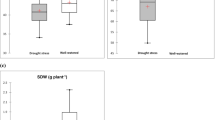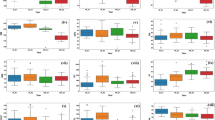Abstract
Drought poses a severe threat to global wheat production and world food security. This study was conducted to evaluate bread wheat genotypes for drought tolerance based on different morphological, biochemical, and physiological traits. The responses of 25 bread wheat genotypes of Pakistani origin were evaluated based on morphological, biochemical, and physiological traits under optimal (70% water holding capacity (WHC)) and drought stress (35% WHC) conditions. Sufficient genotypic variability was noted in the tested genotypes on the morphological (shoot length, relative leaf water contents, and seedling dry weight), biochemical (membrane injury index, leaf free proline, and total soluble phenolic contents), and physiological traits (chlorophyll meter value, intercellular CO2 concentration (Ci), stomatal conductance (gs), photosynthetic rate (A), ratio of photosynthetic rate and intercellular CO2 concentration (A/Ci), transpiration rate (T), and instantaneous water use efficiency (WUEins)) under both control and drought stress conditions. The principal component analysis (PCA) under drought stress showed 78.3% variability of morpho-biochemical traits and 67.0% of physiological traits. Bi-plot of PCA showed the genotypes SQU-2, SQU-4, SQU-10, and SQU-11 are tolerant under drought stress and grouped based on high A, and A/Ci. Similarly, the genotypes SQU-8, SQU-9, SQU-14, SQU-15, SQU-16, and SQU-24 were also tolerant and grouped based on high WUEins and Ci under drought stress. In conclusion, significant genotypic variability was found among the tested wheat genotypes based on morphological, biochemical, and physiological traits, which can be used in future breeding programs to develop drought-tolerant bread wheat genotypes. The genotypes SQU-9, SQU-10, SQU-7, and SQU-13 had better growth under drought stress than other genotypes due to the accumulation of free proline and soluble phenolics which helped maintain tissue water status and sustained the photosynthesis.






Similar content being viewed by others
References
Anyia A, Herzog H (2004) Water-use efficiency, leaf area and leaf gas exchange of cowpeas under mid-season drought. Eur J Agron 20:327–339. https://doi.org/10.1016/S1161-0301(03)00038-8
Barr HD, Weatherley PE (1962) A re-examination of the relative turgidity technique for estimating water deficit in leaves. Aust J Biol Sci 15:413–428
Bates LS, Waldren RP, Teare ID (1973) Rapid determination of free proline for water-stress studies. Plant Soil 39:205–207. https://doi.org/10.1007/BF00018060
Bhaskarla V, Zinta G, Ford R, Jain M, Varshney RK, Mantri N (2020) Comparative root transcriptomics provide insights into drought adaptation strategies in chickpea (Cicer arietinum L.). Int J Mol Sci 21:1781. https://doi.org/10.3390/ijms21051781
Blum A, Ebercon A (1981) Cell membrane stability as a measure of drought and heat tolerance in wheat. Crop Sci 21:43–47. https://doi.org/10.2135/cropsci1981.0011183X002100010013x
Borrel AK, Hammer GL, Henzell RG (2000) Does maintaining green leaf area in sorghum improve yield under drought? II. Dry matter production and yield. Crop Sci 40:037–1048. https://doi.org/10.2135/cropsci2000.4041037x
Chemikosova SB, Pavlencheva NV, Gur’yanov OP, Gorshkova TA (2006) The effect of soil drought on the phloem fiber development in long-fiber flax. Russ J Plant Physiol 53:656–662. https://doi.org/10.1134/S1021443706050098
Cornic G (2000) Drought stress inhibits photosynthesis by decreasing stomatal aperture-not affecting ATP synthesis. Trends Plant Sci 5:187–188. https://doi.org/10.1016/S1360-1385(00)01625-3
Cruz de Carvalho R, Cunha A, da Silva JM (2011) Photosynthesis by six Portuguese maize cultivars during drought stress and recovery. Acta Physiol Plant 33:359–374. https://doi.org/10.1007/s11738-010-0555-1
Dong C, Shao L, Wang M, Liu G, Liu H, Xie B, Li B, Fu Y, Liu H (2016) Wheat carbon dioxide responses in space simulations conducted at the Chinese Lunar Palace-1. Agron J 108:32–38. https://doi.org/10.2134/agronj15.0265
Easterling DR, Meehl GA, Parmesan C, Changnon SA, Karl TR, Mearns LO (2000) Climate extremes: observations, modeling, and impacts. Science 289:2068–2074. https://doi.org/10.1126/science.289.5487.2068
Farooq M, Hussain M, Siddique KHM (2014) Drought stress in wheat during flowering and grain-filling periods. Crit Rev Plant Sci 33:331–349. https://doi.org/10.1080/07352689.2014.875291
Farooq M, Ullah A, Lee DJ, Alghamdi SS (2018a) Terminal drought-priming improves the drought tolerance in desi and kabuli chickpea. Int J Agri Biol 30:1129-36. https://doi.org/10.17957/IJAB/15.0623.
Farooq M, Ullah A, Lee DJ, Alghamdi SS, Siddique KHM (2018b) Desi chickpea genotypes tolerate drought stress better than kabuli types by modulating germination metabolism, trehalose accumulation, and carbon assimilation. Plant Physiol Biochem 126:47–54. https://doi.org/10.1016/j.plaphy.2018.02.020
Farooq M, Wahid A, Kobayashi N, Fujita D, Basra SMA (2009) Plant drought stress: effects, mechanisms and management. Agron Sustain Dev 29:185–212. https://doi.org/10.1051/agro:2008021
Farooq M, Ullah A, Al-Hinai S, Nadaf SK, Al-Sadi AM, Al-Farsi SM, Alkhamisi SA (2022) Wheat production in Oman: experiences, challenges and opportunities. J Agric Marine Sci 27:41–49. https://doi.org/10.24200/jams.vol27iss1pp41-49.
Fatiukha A, Deblieck M, Klymiuk V, Merchuk-Ovnat L, Peleg Z, Ordon F, Fahima T, Korol A, B, Saranga Y, Krugman T (2019) Genomic architecture of phenotypic plasticity of complex traits in tetraploid wheat in response to water stress. bioRxiv 565820. https://doi.org/10.1101/565820.
Flexas J, Barbour MM, Brendel O, Cabrera HM, Carriquı M, Dıaz-Espejo A, Douthe C, Dreyer E, Ferrio JP, Gago J, Galle A, Galmes J, Kodama N, Medrano H, Niinemets U, Peguero-Pina JJ, Pou A, Ribas-Carbo M, Tomas M, Tosens T, Warren CR (2012) Mesophyll diffusion conductance to CO2: an unappreciated central player in photosynthesis. Plant Sci 193–194:70–84. https://doi.org/10.1016/j.plantsci.2012.05.009
Flexas J, Bota J, Loreto F, Cornic G, Sharkey T (2004) Diffusive and metabolic limitations to photosynthesis under drought and salinity in C3 plants. Plant Biol 6:269–279. https://doi.org/10.1055/s-2004-820867
Gratani L (2014) Plant phenotypic plasticity in response to environmental factors. Adv Bot 222:1235–1241. https://doi.org/10.1155/2014/208747
Julkenen-Titto R (1985) Phenolic constituents in the leaves of northern willows: methods for the analysis of certain phenolics. J Agric Food Chem 33:213–217. https://doi.org/10.1021/jf00062a013
Lawlor DW, Cornic G (2002) Photosynthetic carbon assimilation and associated metabolism in relation to water deficits in higher plants. Plant Cell Environ 25:275–294. https://doi.org/10.1046/j.0016-8025.2001.00814.x
Liu X, Zhang H, Wang J, Wu X, Ma S, Xu Z, Zhou T, Xu N, Tang X, An B (2019) Increased CO2 concentrations increasing water use efficiency and improvement PSII function of mulberry seedling leaves under drought stress. J Plant Interact 14:213–223. https://doi.org/10.1080/17429145.2019.1603405
Lonbani M, Arzani A (2011) Morpho-physiological traits associated with terminal drought stress tolerance in Triticale and wheat. Agric Res 9:315–329
Mahajan S, Tuteja N (2005) Cold, salinity and drought stresses: an overview. Arch Biochem Biophy 444:139–158. https://doi.org/10.1016/j.abb.2005.10.018
Mashilo J, Odindo AO, Shimelis HA, Musenge P, Tesfay SZ, Magwaza LS (2017) Drought tolerance of selected bottle gourd [Lagenaria siceraria (Molina) Standl.] landraces assessed by leaf gas exchange and photosynthetic efficiency. Plant Physiol Biochem 120:75–87. https://doi.org/10.1016/j.plaphy.2017.09.022
Medrano H, Tomasa M, Martorell S, Flexas J, Hernandez E, Rossello J, Poub A, Escalona JS, Bota J (2015) From leaf to whole-plant water use efficiency (WUE) in complex canopies: limitations of leaf WUE as a selection target. Crop J 3:220–228. https://doi.org/10.1016/j.cj.2015.04.002
Merah O (2001) Potential importance of water status traits for durum wheat improvement under Mediterranean conditions. J Agri Sci 137:139–145. https://doi.org/10.1017/S0021859601001253
Nayyar H, Walia DP (2003) Water stress induced proline accumulation in contrasting wheat genotypes as affected by calcium and abscisic acid. Biol Plant 46:275–279. https://doi.org/10.1023/A:1022867030790
Nicotra AB, Davidson A (2010) Adaptive phenotypic plasticity and plant water use. Funct Plant Biol 37:117–127. https://doi.org/10.1071/FP09139
Quintero A, Molero G, Reynolds MP, Calderini DF (2018) Trade-off between grain weight and grain number in wheat depends on G×E interaction: a case study of an elite CIMMYT panel (CIMCOG). Eur J Agron 92:17–29. https://doi.org/10.1016/j.eja.2017.09.007
Shiferaw B, Smale M, Braun HJ, Duveiller E, Reynolds M, Muricho G (2013) Crops that feed the world 10. Past successes and future challenges to the role played by wheat in global food security. Food Secur 5:291–317. https://doi.org/10.1007/s12571-013-0263-y
Sourour A, Afel O, Mounir R, Mongi BY (2017) A review: morphological, physiological, biochemical and molecular plant responses to water deficit stress. Inter J Engg Sci 6:01–04
Stiling P, Moon D, Rossi A, Forkner R, Hungate BA, Day FP, Drake B (2013) Direct and legacy effects of long-term elevated CO2 on fine root growth and plant-insect interactions. New Phytol 200:788–795. https://doi.org/10.1111/nph.12295
Subbarao GV, Nam NH, Chauhan YS, Johansen C (2000) Osmotic adjustment, water relations and carbohydrate remobilization in pigeonpea under water deficits. J Plant Physiol 157:651–659. https://doi.org/10.1016/S0176-1617(00)80008-5
Taleisnik E, Rodriguez AA, Bustos D, Erdei L, Ortega L, Senn ME (2009) Leaf expansion in grasses under salt stress. J Plant Physiol 166:1123–1140. https://doi.org/10.1016/j.jplph.2009.03.015
Wang H, Zhang M, Guo R, Shi D, Liu B, Lin X, Yang C (2012) Effects of salt stress on ion balance and nitrogen metabolism of old and young leaves in rice (Oryza sativa L.). BMC Plant Biol 12:194. https://doi.org/10.1186/1471-2229-12-194
Ullah A, Farooq M (2021) The challenge of drought stress for grain legumes and options for improvement. Arch Agron Soil Sci 29:1–8. https://doi.org/10.1080/03650340.2021.1906413
Ullah A, Al-Rajhi RS, Al‑Sadi AM, Farooq M (2021) Wheat genotypes with higher intercellular CO2 concentration, rate of photosynthesis, and antioxidant potential can better tolerate drought stress. J Soil Sci Plant Nutr. https://doi.org/10.1007/s42729-021-00529-6.
Zulkiffal M, Ahsan A, Ahmed J, Musa M, Kanwal A, Saleem M, Anwar J, ur Rehman A, Ajmal S, Gulnaz S, Javaid MM (2021). Heat and drought stresses in wheat (Triticum aestivum L.): substantial yield losses, practical achievements, improvement approaches, and adaptive. In: Plant Stress Physiology, Hossain, A., (Ed.). https://doi.org/10.5772/intechopen.92378.
Zhang L, Zhang L, Sun J, Zhang Z, Ren H, Sui X (2013) Rubisco gene expression and photosynthetic characteristics of cucumber seedlings in response to water deficit. Sci Hort 161:81–87. https://doi.org/10.1016/j.scienta.2013.06.029
Acknowledgements
We are thankful to different Wheat Research Institutes of Pakistan for provision of plant material.
Funding
The financial support to conduct this study is received from “His Majesty Trust Fund” Sultan Qaboos University, (SR/AGR/CROP/19/01), Oman.
Author information
Authors and Affiliations
Corresponding author
Ethics declarations
Conflict of Interest
The authors declare no competing interests.
Additional information
Publisher's Note
Springer Nature remains neutral with regard to jurisdictional claims in published maps and institutional affiliations.
Supplementary Information
Below is the link to the electronic supplementary material.
Rights and permissions
About this article
Cite this article
Ullah, A., Al-Busaidi, W.M., Al-Sadi, A.M. et al. Bread Wheat Genotypes Accumulating Free Proline and Phenolics Can Better Tolerate Drought Stress Through Sustained Rate of Photosynthesis. J Soil Sci Plant Nutr 22, 165–176 (2022). https://doi.org/10.1007/s42729-021-00641-7
Received:
Accepted:
Published:
Issue Date:
DOI: https://doi.org/10.1007/s42729-021-00641-7




